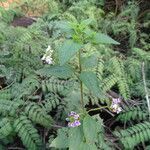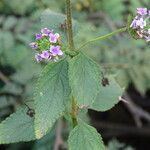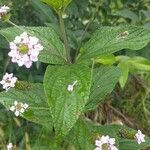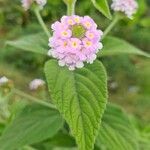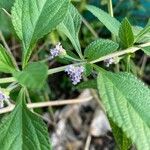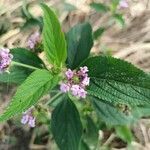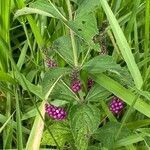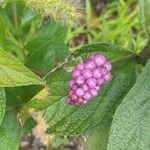Perennial herbs with woody underground stems or subshrubs to 2.5 m high; stems usually appressed-pubescent or strigose, the trichomes short and closely appressed or subappressed to the upper part of the stems. Leaves mostly ternate, usually membranous, oblong-lanceolate to elliptic-lanceolate or ovate, petiolate, 5-12 cm long, acute or acuminate apically, crenate-serrate, attenuate basally and decurrent into the petiole, often reticulate-rugose above and scabrous or more or less strigose-pubescent, densely resinous-punctate and scattered-puberulent or-strigillose beneath. Inflorescences spicate, subcapitate when young, later cylin-dric and elongating to 4.5 cm long, densely many-flowered; spikes at first sub-globose, 1-1.5 cm in diameter; peduncles slender, usually shorter than or equaling the subtending leaves, 2-10.5 cm long, densely strigose-pubescent, solitary in each leaf-axil; bractlets herbaceous, green, lanceolate or ovate, the lowest to 10 mm long and 3 mm wide, cuspidate-acuminate apically, 5-nerved, strigose above, loosely imbricate, the upper with the cusp about equaling the corolla-tube. Flowers with the corolla pink, lavender, lilac, or purple, the tube 5-6 mm long. Drupes fleshy, purple or lavender, 2-3 mm in diameter.
Leaves aromatic, mostly 3-whorled with some leaves opposite, petiolate; lamina (2.5)5–14 × (1)2–6 cm, mostly 6–8 × 3–4.5 cm, usually 2.5–3 times longer than wide, ovate-lanceolate to lanceolate, or ovate to ovate-oblong or elliptic, ± attenuate towards the apex and ± acute, ± cuneate at the base and somewhat decurrent into the petiole or sometimes rounded and slightly contracted at the base, closely crenate or crenate-serrate on the margins and 24–34(39) shallowly toothed on each side, membranous to somewhat coriaceous becoming somewhat rigid on drying, ± concolorous, shortly and sparsely hispidulous to strigose on upper surface, becoming ± scabridulous with the tubercle-bases persisting in older leaves, puberulous or shortly tomentose beneath, rarely pilose; venation somewhat impressed above but lamina not bullate ± raised or obscure beneath; petiole slender.
A scrambling shrub. It grows 3 m high. The stems are thin and have hairs. The leaves are in threes. They are oval and taper to the tip. The base is rounded and there are teeth along the edge. They are like sandpaper above. The flowers are usually pink or lilac. They are in spikes on long stalks. They form round heads. The fruit are red or purple berries.
Flowering spikes 0.8–1.0 × 1.3–1.7 cm, hemispheric, up to 1.7–4.5(5) cm and ± cylindrical in fruit; lower bracts 8–12(14) × 3–5(6.5) mm and ovate-elliptic tapering into an attenuate-subulate apex, or 7.5–9.5 × 4–4.5 and ovate with a tapering-acute apex; upper bracts successively smaller; spike-axes up to 5 cm long, with scattered scars.
Branches somewhat 4-angled, often purplish, with internodes 2.5–10 cm long, ± weakly strigose with short ± tubercle-based hairs usually curving or ± appressed antrorse, or somewhat hispid with stouter spreading bristle-like hairs, usually with sessile glands intermixed.
Peduncles usually 1 per leaf axil or sometimes 2 (up to 6 per node), somewhat rigid, straight, slender, 1.5–9(10) cm long at anthesis, usually shorter than the subtending leaf (petiole included), increasing to 11 cm long in fruit.
Corolla usually white (in plants of the Flora Zambesiaca area), sometimes mauvish-white, very light pink, rarely pink or purple with yellow throat; tube 5–6(7) mm long; lower-lip 5–5.5 mm broad.
Perennial herb or subshrub, up to 2.5 m high. Stems appressed-pubescent or strigose. Leaves ternate. Inflorescence elongate, spicate. Flowers pink, lavender, lilac or purple.
A weak-stemmed shrub 0.9–3 m tall, or sometimes a woody subshrub.
A woody herb or subshrub, to about 6 ft. high, sparsely branched
Drupes 3–3.5 × 2.5–3 mm, mauve to purple.
Rugose scabrid leaves in threes
Calyx thinly membranous.
Anthers c. 0.5 mm long.
Flowers pink or mauve
Fruits purple.
Hairy stems
